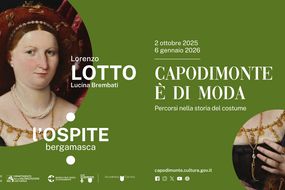From 10 May to 31 December 2025
The work, restored to its full readability and visitable from May 10th at the Museum of Santa Giulia, is destined to remain on display for a long time in the museum's path, in dialogue with the crucifixion of the suffering saints Catherine and Jerome in the chapel of the Madonna of the basilica of San Salvatore and with the death of Saint Obizio, also in San Salvatore.
The fresco, described in flattering tones by the Brescian painter and art writer Francesco Paglia, comes from the exterior of the city chapel of Saints Hippolytus and Cassian, once located between Martyrs of Belfiore Square and Gabriele Rosa Street and demolished in 1904, where the Madonna del Latte was placed within a masonry altar on the southern wall of the building. The subject is one of the most recurring in Christian iconographic tradition: the Virgin, seated on a throne, extends her left hand in a welcoming gesture, while on her lap she supports the Child who, holding onto the mother's breast, interrupts breastfeeding by turning to the observer.
The author of the painting was only recently identified as Andrea Marone from Manerbio, a member of a family of artists probably originating from Sebino but well established in the city. As noted by Fiorella Frisoni (2018), the painter during his activity carried out between Brescia, Bassa Bresciana, and Lake Iseo, showed "an orientation different from the extraordinary experience of the three greats" (Moretto, Romanino, and Savoldo), taking as a reference point not so much Venice, but Cremona, Lodi, and Milan, but also the areas of the Lombard lakes, up to Canton Ticino. His models are indeed to be recognized in artists such as the Cremonese Boccaccio Boccaccino and Galeazzo Campi, the Lodigiani Piazza, up to Bernardino Luini of the Milanese frescoes of San Maurizio al Monastero Maggiore (twenties of the sixteenth century). The reflection of these stylistic orientations is also evident in the Brescian fresco, as can be seen from the formal elegance of the faces, rendered with delicate hatched highlights, the redundant and draped draperies, and the chromatically calibrated layers. And if the overall layout is characterized by an archaic - almost neo-medieval arrangement, observing the still fifteenth-century setting of the angels in the upper register - it is the details, enhanced by the recent restoration, that make the difference in terms of quality: the filamentous curls of the Child, the glazed reflections of the nails, the golden inserts of the halos and the crown and neckline of the Virgin.
Along the exhibition path of the Museum of Santa Giulia, inside the church of San Salvatore, other frescoes attributed to Andrea Marone from Manerbio can be admired: the Crucifix with the suffering, Saint Catherine of Alexandria and Saint Jerome in the chapel of the Madonna, and the Death of Saint Obizio, on the upper order of the wall separating the church hall from the adjacent nuns' choir.
The fresco, which was the object of heartfelt popular devotion, was detached in 1878 by the Brescian restorer Giuliano Volpi on behalf of the Municipality. The painted plaster was removed along with a significant portion of the underlying masonry: this particular extraction technique is called "stacco a massello."

Via dei Musei, 81/b, Brescia, Italy
Opening hours
| opens - closes | last entry | |
| monday | Closed now | |
| tuesday | 10:00 - 18:00 | 17:15 |
| wednesday | 10:00 - 18:00 | 17:15 |
| thursday | 10:00 - 18:00 | 17:15 |
| friday | 10:00 - 18:00 | 17:15 |
| saturday | 10:00 - 18:00 | 17:15 |
| sunday | 10:00 - 18:00 | 17:15 |
The museum is closed every Monday, except on holidays.
Information and reservations (service available from Monday to Saturday, 10-18)

From 19 September to 11 January 2026
Pavia 1525: the arts in the Renaissance and the tapestries of the battle

Civic Museums of the Visconti Castle, Pavia

From 2 October to 6 January 2026
The Guest from Bergamo Lucina Brembati by Lorenzo Lotto

Capodimonte Museum, Naples